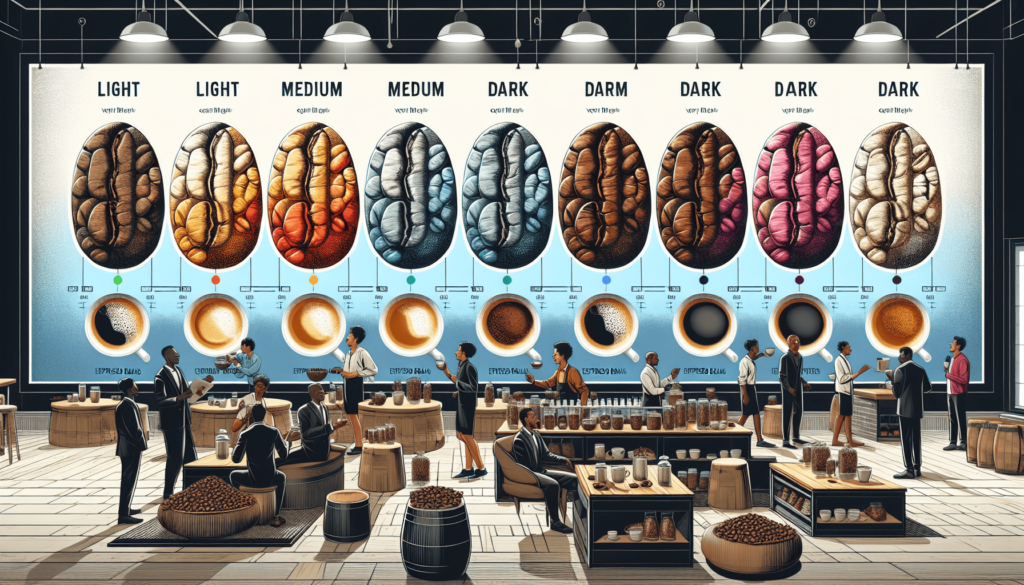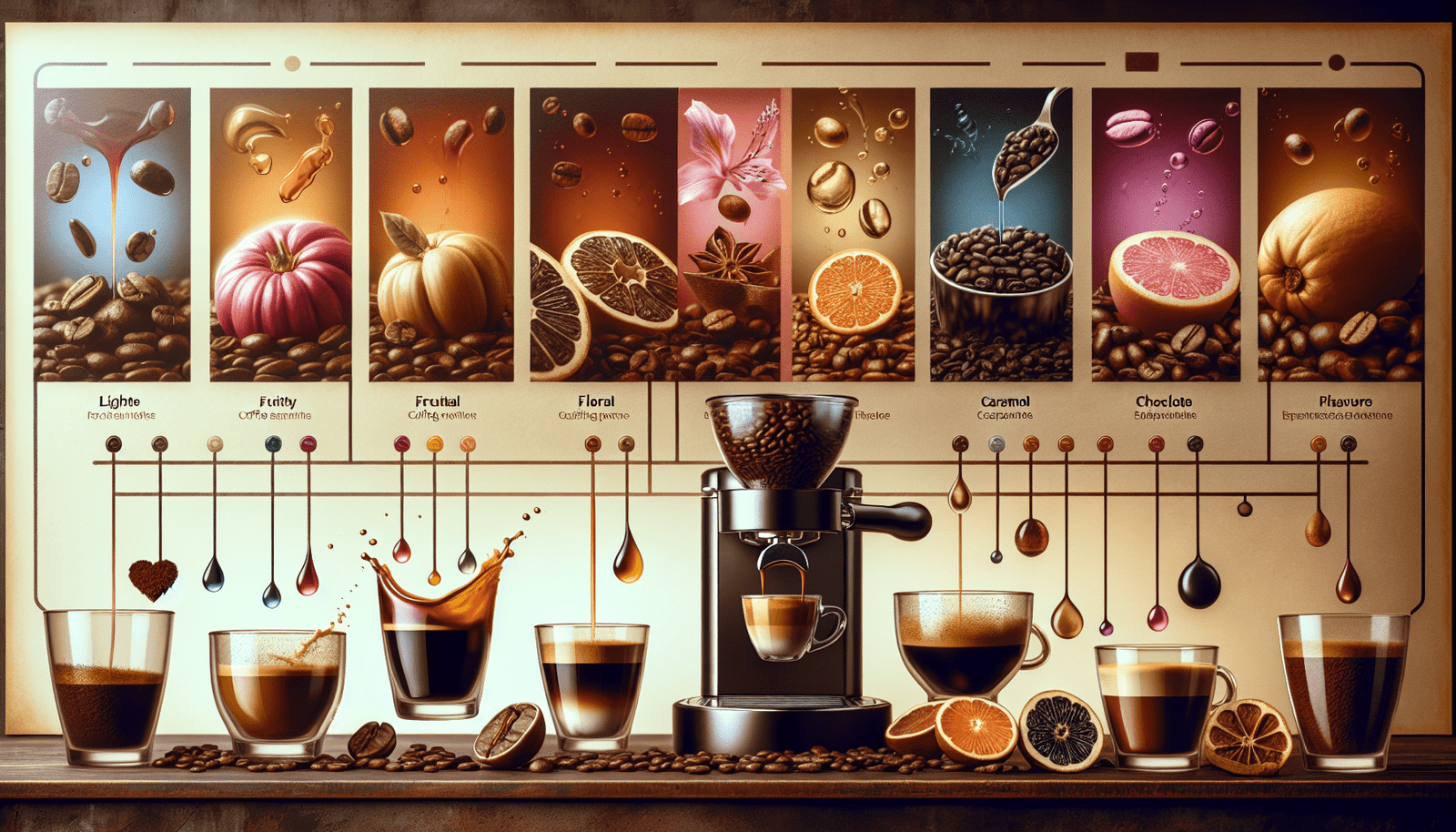When it comes to the ultimate cup of espresso, the roast level of your beans plays a crucial role in determining its flavor and aroma. From the light and delicate flavors of a light roast to the bold and intense notes of a dark roast, finding the perfect balance can elevate your coffee experience to new heights. In this article, we will explore the art of finding the ideal roast level for your espresso beans, guiding you through the different options and helping you discover the taste that best suits your preferences. So grab your favorite mug and get ready to unlock the secret to the perfect espresso roast.

Understanding Roast Levels
Roasting is a crucial step in coffee bean processing that greatly affects the flavor and characteristics of your espresso. Understanding the different roast levels is key to finding the perfect cup of espresso that matches your preferences. Let’s take a look at the three main roast levels: light roast, medium roast, and dark roast.
Light Roast
Light roast espresso is characterized by its light brown color and minimal oil on the surface of the beans. This roast level preserves the bean’s original flavors and acidity, making it a great choice for those who enjoy bright and vibrant espresso. The flavor profile of light roast espresso tends to showcase fruity, floral, and tea-like characteristics, with subtle acidity and a light body.
Medium Roast
Medium roast espresso falls in between light and dark roasts in terms of color and flavor intensity. The beans are medium brown and have a richer taste compared to light roast. There is a balance between acidity and bitterness, offering a more rounded and well-developed flavor profile. Medium roast espresso often exhibits notes of chocolate, nuts, and caramel, with a medium body and moderate acidity.
Dark Roast
Dark roast espresso is bold and full-bodied. The beans are dark brown to almost black in color, with an oily surface. This roast level brings out the rich, smoky, and robust flavors of the coffee, accompanied by a lower acidity. Dark roast espresso tends to have a heavy and lingering mouthfeel, making it a popular choice for those who prefer a strong and intense espresso experience.
Effects of Roast Levels on Espresso
Understanding the effects of roast levels on espresso is essential in choosing the right roast for your personal taste. Here are some key factors influenced by roast levels:
Flavor Profile
Roast levels significantly impact the flavor profile of your espresso. Light roast espresso preserves the delicate flavors and floral notes, while medium roast offers a balance between acidity and bitterness. Dark roast espresso tends to exhibit stronger and more intense flavors, with smoky and sometimes charred undertones.
Acidity
Acidity in espresso refers to the bright and tangy notes that enhance the overall flavor. Light roast espresso typically has higher acidity due to the retention of natural acids in the beans. Medium roast espresso strikes a harmony between acidity and bitterness, while dark roast espresso tends to have lower acidity.
Body and Mouthfeel
The body of espresso refers to the weight and texture in the mouth. Light roast espresso usually has a lighter body, while medium roast espresso offers a medium body with a smooth and velvety texture. Dark roast espresso tends to have a heavier body, resulting in a bold and full-mouth experience.
Aroma
The aroma of espresso is a crucial aspect of the overall coffee experience. Light roast espresso often exhibits floral and tea-like aromas. Medium roast espresso releases more caramel and chocolate notes in its aroma. Dark roast espresso is known for its intense and smoky aroma, which some coffee lovers find irresistible.
Factors to Consider
When choosing the perfect roast level for your espresso, consider the following factors:
Personal Preference
Your personal taste is the ultimate guide in selecting the ideal roast level. Experiment with different roast levels to find the one that brings out the flavors and characteristics you enjoy the most. Don’t be afraid to try something new and step out of your comfort zone.
Bean Origin
The origin of the beans also plays a role in determining the ideal roast level. Different coffee regions produce beans with distinct flavors and characteristics. For example, beans from Central America often have delicate and fruity flavors, while beans from South America may exhibit nutty and caramel notes. Understanding the flavor profiles associated with various origins can help you make an informed decision.
Brewing Method
Different brewing methods can enhance or diminish the qualities of specific roast levels. For espresso, the concentrated extraction puts more emphasis on the flavors and body of the coffee. Light roast espresso may shine with a more nuanced flavor profile, while dark roast espresso can hold up well in milk-based beverages.
Espresso Blend
Espresso blends are carefully crafted combinations of different bean origins and roast levels. These blends are designed to achieve a specific flavor profile and consistency. Consider exploring different espresso blends to experience a range of flavors and find your ideal roast level within a blend.
Light Roast Espresso
Light roast espresso offers a unique and delicate flavor experience. Here are the characteristics, flavor notes, and recommended brewing ratio for light roast espresso:
Characteristics
Light roast espresso is known for its light brown color and minimal oil on the beans’ surface. It has a bright and vibrant flavor profile with high acidity and a light body. Light roast espresso brings out the natural flavors of the beans and offers a crisp and clean taste.
Flavor Notes
The flavor notes of light roast espresso are often described as fruity and floral, with hints of citrus, berries, and tea-like qualities. The acidity is pronounced, adding a refreshing and lively element to the espresso. Light roast espresso is an excellent choice for those who enjoy a bright and complex cup of coffee.
Recommended Brewing Ratio
For light roast espresso, a recommended brewing ratio is using 1:2 coffee to water ratio, such as 20 grams of coffee for 40 grams of water. This brewing ratio allows you to extract the delicate flavors and maintain the balance between acidity and sweetness.

Medium Roast Espresso
Medium roast espresso strikes a balance between light and dark roasts, offering a flavorful and well-rounded cup of coffee. Let’s explore the characteristics, flavor notes, and recommended brewing ratio for medium roast espresso:
Characteristics
Medium roast espresso has a medium brown color and a slightly richer taste compared to light roast. It showcases a balance between acidity and bitterness, resulting in a more rounded and full-bodied espresso. Medium roast espresso is a popular choice among coffee lovers who desire a well-developed flavor profile.
Flavor Notes
The flavor notes of medium roast espresso encompass a wide range of taste profiles. It often displays notes of chocolate, nuts, caramel, and sometimes even some fruitiness. The acidity is moderate, harmonizing with the other flavors to create a balanced and enjoyable espresso experience.
Recommended Brewing Ratio
For medium roast espresso, a recommended brewing ratio is still the 1:2 coffee to water ratio. Adjust the amount according to your preference, but using 20 grams of coffee for 40 grams of water is a good starting point. This brewing ratio allows the flavors to be extracted adequately, resulting in a well-balanced and flavorful cup of espresso.
Dark Roast Espresso
Dark roast espresso is bold, intense, and perfect for those who prefer a strong and robust coffee experience. Let’s delve into the characteristics, flavor notes, and recommended brewing ratio for dark roast espresso:
Characteristics
Dark roast espresso is recognized by its dark brown to almost black color and oily surface. It has a rich and smoky flavor profile, bringing out the deep and intense qualities of the coffee. Dark roast espresso tends to have a heavy and lingering mouthfeel, making it an excellent choice for those who crave a strong and bold espresso.
Flavor Notes
The flavor notes of dark roast espresso are often described as deep, robust, and sometimes even charred. It exhibits flavors of dark chocolate, caramel, toasted nuts, and may even have some smoky undertones. The acidity in dark roast espresso is low, providing a mellow and earthy taste experience.
Recommended Brewing Ratio
For dark roast espresso, a recommended brewing ratio is still the 1:2 coffee to water ratio. Using 20 grams of coffee for 40 grams of water is a suitable starting point. This brewing ratio allows for a rich extraction, accentuating the bold flavors and maintaining the balance between bitterness and sweetness.
Experimenting with Roast Levels
If you’re feeling adventurous and want to explore the world of roast levels, there are several ways to experiment and find your perfect cup of espresso:
Blending Different Roasts
Mixing different roast levels can result in unique flavor profiles. You can create your own blend by combining light, medium, and dark roast beans in various ratios. Experiment with different combinations to find a blend that suits your taste preferences.
Adjusting Brew Parameters
Minor adjustments in your brewing parameters, such as grind size, water temperature, and brew time, can have a significant impact on the flavors extracted from different roast levels. Play around with these variables to discover the nuances and hidden flavors of each roast level.
Tasting and Evaluating Results
The best way to understand the effects of roast levels is through taste testing. Brew espresso using various roast levels and take notes on the flavor, acidity, body, and overall experience. Pay attention to the differences and similarities among the roasts to gain a deeper understanding of your preferences.
Tips for Selecting Roast Level
When selecting the ideal roast level for your espresso, consider these helpful tips:
Try Small Batches
Purchase smaller quantities of coffee beans in different roast levels to explore your preferences. This way, you can try various roast levels without committing to a large amount of beans.
Explore Single Origin Beans
Single origin beans are sourced from a specific region, allowing you to experience the unique flavors and characteristics offered by that particular origin. Try single origin beans in different roast levels to discover new and exciting taste profiles.
Consult with Coffee Experts
If you’re unsure about which roast level to choose, don’t hesitate to seek guidance from coffee experts or baristas. They can help you navigate the world of roast levels and suggest options based on your preferences.
Roasting Your Own Espresso Beans
For those coffee enthusiasts who want complete control over their espresso experience, home roasting is an exciting option. Here are the benefits of home roasting, the equipment needed, and some roasting techniques to get you started:
Benefits of Home Roasting
Roasting your own espresso beans allows you to customize the roast level to your exact preference. You can experiment with different roast profiles, bean origins, and blends to create a truly personalized espresso experience. Home roasting also ensures the freshest coffee possible, as you can roast small batches as needed.
Equipment Needed
To roast your own espresso beans, you’ll need a few essential pieces of equipment. A home coffee roaster, such as a dedicated roasting machine or even a popcorn popper modified for roasting, is necessary. Additionally, you’ll need a kitchen timer, a scale for weighing the beans, and a colander or cooling tray to cool the roasted beans quickly.
Roasting Techniques
There are different techniques for home roasting espresso beans, including air roasting, drum roasting, and stove-top methods. Each method has its own unique characteristics and requires varying degrees of involvement. Research the different techniques and choose one that suits your preferences and equipment.
Conclusion
Finding the perfect roast level for your espresso beans is a journey of taste exploration and personal preference. Understanding the characteristics, flavor profiles, and effects of different roast levels allows you to make an informed decision. Don’t be afraid to experiment with different roasts, brewing methods, and bean origins. By fine-tuning your espresso experience, you’ll be able to enjoy a cup of coffee that perfectly suits your preferences. Happy brewing!

